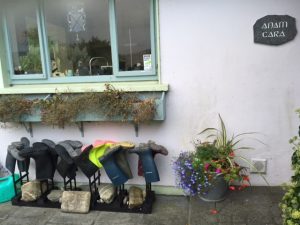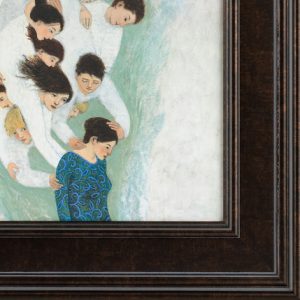I’ve been making my difficult and sometimes dreary way through Clyde Forsberg’s ninety-eight-dollar tome Divine Rite of Kings (review arriving shortly), wishing I could see the good. His thesis is generally nasty: Mormonism, like its parent organization the Masons, is racist, sexist, empire-building and xenophobic, and no good can come out of Joseph Smith or his minions. He quotes sources without establishing their ethos — so many it makes my head spin, just taunting me to say this is exhaustively-researched and thoroughly cited — but mostly the book tastes bad, an eight-course meal in a foreign country whose ingredients don’t agree with my stomach and whose spices and oils never smelled right from the start. I’m almost done, and I haven’t found a way to recommend any of it.
Details will come later, in the review. Significantly, some other things have been going on this month that deserve attention. The election – yeah, that. (I hereby vow not to write about the nasty there. You’ve already heard too much.) But another thing going on right now is Nanowrimo.
NOT nasty.
Pretty nice, in fact.
Now, maybe I’m preaching to the choir. Maybe you’re all doing Nano, have done it every year for ages. (Whatever “ages” means to you, which depends on your age, I guess.)
When I first heard of Nanowrimo — National Novel Writing Month, the November writing marathon that attracts thousands and thousands of writer wannabes, encouraging and motivating with the magic number fifty thousand—fifty thousand words and you win!—when I first heard of it, I thought, that’s just a crutch for amateurs. Real writers don’t need Nano. Writing is part of our schedule. It isn’t a one-month binge.
But then I tried it.
 I consider myself a real writer. I’ve published stories (and now a book) and reviews and essays, I have a doctorate in fiction writing. I present at conferences. But one October not too long ago I spent some time at Anam Cara, a beautiful sanctuary for writers and artists in the southwest of Ireland whose clientele has included such Mormon writers as Mary Bradford and Susan Elizabeth Howe. There I began serious work on a new piece I’d been thinking about for over a year (not Pigs). I received trenchant feedback on my efforts there, and I needed an incentive to continue what I’d started. It would have been a sad setback to let it sink under the weight of papers to grade, faculty meetings to attend, hiring searches to chair. Nanowrimo came at just the right time, and I finished a novel draft the first November I tried it.
I consider myself a real writer. I’ve published stories (and now a book) and reviews and essays, I have a doctorate in fiction writing. I present at conferences. But one October not too long ago I spent some time at Anam Cara, a beautiful sanctuary for writers and artists in the southwest of Ireland whose clientele has included such Mormon writers as Mary Bradford and Susan Elizabeth Howe. There I began serious work on a new piece I’d been thinking about for over a year (not Pigs). I received trenchant feedback on my efforts there, and I needed an incentive to continue what I’d started. It would have been a sad setback to let it sink under the weight of papers to grade, faculty meetings to attend, hiring searches to chair. Nanowrimo came at just the right time, and I finished a novel draft the first November I tried it.
This year I’m doing it again.
Nano doesn’t edit or even check your draft—it only validates your word count. To the Nano gods, it doesn’t matter how many people make fifty thousand words. Nano isn’t a competition—everybody wins when they hit fifty thou. And “the world needs your novel,” they keep saying. “Come to a write-in.” “Try this prompt.” “Please donate.” (Whoops, I forgot about that one.) The website is clean and clear. Daily accounting is based on honesty and the participant receives immediate feedback on her progress toward The Goal. It’s nonthreatening and challenging—and, for me, good. My characters are asking each other whether what they’re doing furthers the good in the world, and the question feels organic to me, appropriate to the plot, integral to the questions I’m asking as I write. Thematic, we could say.
This is partly a reaction to Forsberg. But only partly.
Unlike Pigs, this new book does not turn around LDS themes specifically, though an important part of it takes place in Salt Lake City. But the questions it explores do turn around themes of goodness, of rightness, of doing the right work in the right place at the right time with the right helpers, whether they’re Mormon or not. Goodness matters.
 During the panel I sat on with Scott Bronson, Sterling Van Wagenen, Eric Samuelson, and others as part of the Dialogue Jubilee Symposium, artist Brian Kershisnik (whose work is on display these days at the Meyer Gallery in Park City along with the work of Corinne Geertsen, whose images grace the cover of my book) came up with one of the most important takeaways of the day. “I don’t make art to teach,” he said. “I make art to learn. I sense a question, I perceive a gap between what I know and what I have seen, and I go to the canvas to see if I can find an answer.” (Thank you, Brian. I hope I got it right.)
During the panel I sat on with Scott Bronson, Sterling Van Wagenen, Eric Samuelson, and others as part of the Dialogue Jubilee Symposium, artist Brian Kershisnik (whose work is on display these days at the Meyer Gallery in Park City along with the work of Corinne Geertsen, whose images grace the cover of my book) came up with one of the most important takeaways of the day. “I don’t make art to teach,” he said. “I make art to learn. I sense a question, I perceive a gap between what I know and what I have seen, and I go to the canvas to see if I can find an answer.” (Thank you, Brian. I hope I got it right.)
This seems crucial to our work as Mormon fiction writers, however we make use of Mormonish themes. Forsberg has an agenda: to discredit Mormons by juxtaposing them with similar organizations whose bodily functions stink of their mucking about in exclusivity and power-hunger. Writers of Mormon fiction have the right and the responsibility, it seems to me, to come to the page, whether computer or notebook, asking questions before they decide on an agenda. Not only “what if…?” but “why?” and “how could it happen?” and above all, “how do we deal with it so that good comes of it?”
Now, maybe this is too preachy.
Mark Penny, in a response to an interview with Tristi Pinkston in these pages, says that preachiness happens when Elevating and Educating take precedence over Entertaining. That’s a good definition, a good way to think about preachy. I think preachy also happens when we get too sure we have The Answer — when we ask a leading question that has only One Right Response. Because good is complex.
Remember that Edwin Markham poem “[They] drew a circle that shut me out/ Heretic, rebel, a thing to flout/ But Love and I had the wit to win/ We drew a circle that took [them] in”? Art — fiction, nonfiction, criticism, visual art, dance, you name it — whose goal isn’t ultimately goodness can obliviate (forgive me, I just saw “Fantastic Beasts”) whole demographics, whole segments of the population of the world. (Think about that, Mr. Trump. Think about that, Trump opposers. Think about that, everybody.) The difference between goodness and not-goodness is that the not-good turns its back on whatever it deems Other. Means to do it. The good always confronts the Other head-on, including the not-good. Means to do it. If we ask, “How does this difficulty, this paradox, this complication, this knot have potential for good — humor, light, creation, transformation – ?”— then we might have a story worth following up. A story that might end up needing fifty thousand words.
Happy November!

How very encouraging, on a day when I have up to now had no moment to pause or think about my own creative work.
It is, perhaps, arrogant to see divine (and humane) potential in what we as writers do. Except that I think maybe each of us, no matter what we do, ought to look to see the divine (and humane) potential in that thing (or more accurately, those things). Not as a way to put ourselves above others, but rather to remind ourselves why what we do is worth doing.
“Writers of Mormon fiction have the right and the responsibility, it seems to me, to come to the page, whether computer or notebook, asking questions before they decide on an agenda. Not only ‘what if…?’ but ‘why?’ and ‘how could it happen?’ and above all, ‘how do we deal with it so that good comes of it?’”
I love this. Likening it unto myself, I see that it’s exactly how (what I think are) my best works have germinated. The Agitated Heart began with this question: How would I react if my son were the victim of some serious bullying? Immediately, I said to myself, “Oh, I know exactly how I would react; that’s too easy a question. Maybe the better question is, ‘How *should* I react?'”
In trying to find an answer to — altering, slightly, Brian’s thought — the disparity between what I know and what I believe, I think the story went a little beyond the initial thesis. Which is as it should be, I think. The Answers (stories, paintings, sculptures, photos, poems, plays, etc.) that come to us as we seek learning should deal, not only with the questions we have posed, but also the questions we have not asked . . . yet.
This was a very thoughtful — and thought provoking essay — thank you for sharing.